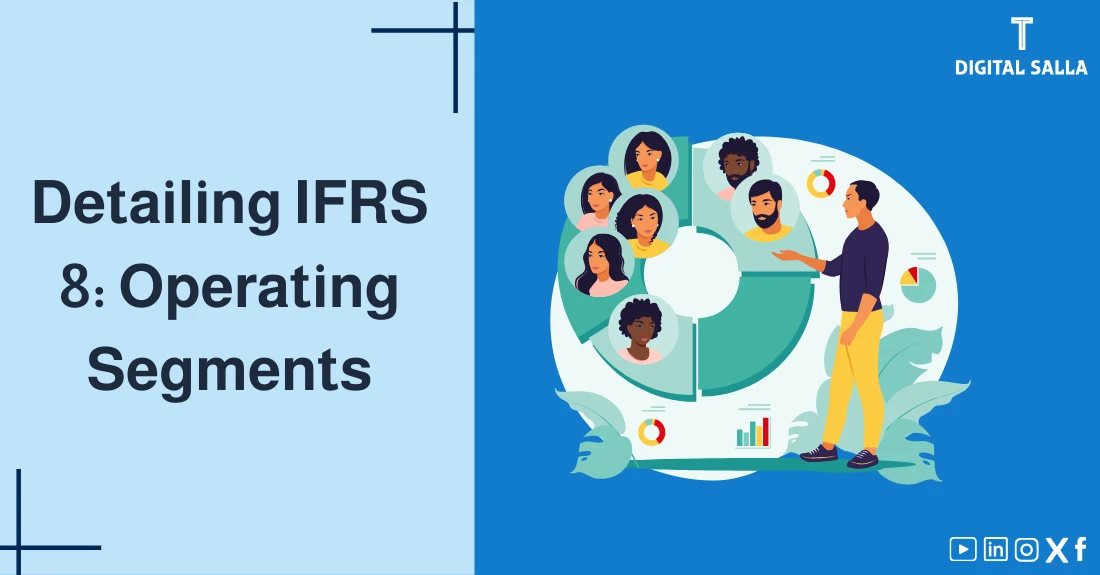Detailing IFRS 8 Standard: Operating Segments

International Financial Reporting Standard (IFRS 8 Standard) “Operating Segments” is one of the International Financial Reporting Standards aimed at enabling financial statement users to assess an entity’s performance from the same perspective that management views its operations. IFRS 8 Standard requires entities to disclose information about their operating segments, including information about each segment’s revenues, expenses, assets, and liabilities. In this article, we will provide a detailed explanation of IFRS 8 Standard, discuss its objectives, scope, and key requirements, focusing on how to identify operating segments and the required disclosures, in addition to highlighting the importance of this standard and its impact on financial statements.
What is IFRS 8 Standard: Operating Segments?
IFRS 8 is an international accounting standard that specifies how entities should disclose information about their operating segments in financial statements. IFRS 8 Standard replaces International Accounting Standard 14 (IAS 14) “Segment Reporting.”
Objectives of IFRS 8 Standard:
- Improve the Quality of Segment Disclosures: IFRS 8 Standard aims to enhance the quality and relevance of information disclosed about an entity’s operating segments.
- Help Financial Statement Users Understand Entity Performance: IFRS 8 helps financial statement users understand how an entity manages its operations, allocates resources, and makes decisions within the entity.
- Enhance Comparability: IFRS 8 Standard contributes to improving the comparability of financial information between companies that apply IFRSs.
- Provide Useful Information for Decision-Making: IFRS 8 provides information that enables investors, creditors, and other stakeholders to better assess an entity’s performance and make informed economic decisions.
Scope of IFRS 8 Standard:
IFRS 8 applies to:
- The separate or individual financial statements of an entity:
- Whose debt or equity instruments are traded in a public market (a domestic or foreign stock exchange or an over-the-counter market, including local and regional markets).
- Or that files, or is in the process of filing, its financial statements with a securities commission or other regulatory organization for the purpose of issuing any class of instruments in a public market.
- The consolidated financial statements of a group with a parent:
- Whose debt or equity instruments are traded in a public market (a domestic or foreign stock exchange or an over-the-counter market, including local and regional markets).
- Or that files, or is in the process of filing, its consolidated financial statements with a securities commission or other regulatory organization for the purpose of issuing any class of instruments in a public market.
In other words, IFRS 8 applies mandatorily to listed companies and companies planning to go public.
Operating Segment:
IFRS 8 Standard defines an operating segment as a component of an entity:
- That engages in business activities from which it may earn revenues and incur expenses (including revenues and expenses relating to transactions with other components of the same entity).
- Whose operating results are regularly reviewed by the entity’s chief operating decision-maker (CODM) to make decisions about resources to be allocated to the segment and assess its performance.
- For which discrete financial information is available.
Important Notes:
- The chief operating decision-maker (CODM) may be the chief executive officer, the board of directors, or any other person responsible for making key decisions about resource allocation and performance evaluation.
- The operating segment does not have to be a separate legal entity.
- The operating segment can be a product line, a geographical area, a business unit, or any other business division used by management to make decisions.
Determining Operating Segments:
The process of determining operating segments follows these steps:
- Identify the Chief Operating Decision-Maker (CODM): The person or group responsible for making key decisions about resource allocation and performance evaluation.
- Identify Activities That Represent Operating Segments: Identify activities that generate revenues and incur expenses, and whose operating results are regularly reviewed by the CODM.
- Aggregate Operating Segments (If Necessary): Two or more operating segments can be aggregated into a single reportable segment if these segments are similar in the following factors:
- Nature of the products and services.
- Nature of the production processes.
- Type or class of customers.
- Methods used to distribute products or provide services.
- Regulatory nature (if applicable).
Reportable Segments:
An entity must disclose separate information about each operating segment that meets any of the following quantitative thresholds:
- Revenue: If the segment’s revenue (including revenue from external sales and revenue from transactions with other segments of the entity) is 10% or more of the combined revenue of all operating segments.
- Profit or Loss: If the absolute amount of the segment’s profit or loss is 10% or more of (a) the combined profit of all profitable segments, or (b) the combined loss of all loss-making segments, whichever is greater.
- Assets: If the segment’s assets are 10% or more of the combined assets of all operating segments.
Notes:
- If the operating segments that meet these quantitative thresholds represent less than 75% of the entity’s total revenue, additional reportable segments must be identified until at least 75% is reached.
- An entity can disclose information about operating segments that do not meet the quantitative thresholds if it believes this information is useful to financial statement users.
Required Disclosures Under IFRS 8 Standard:
IFRS 8 requires entities to disclose information about their operating segments, including:
- General Information:
- Factors used to identify the entity’s operating segments, including the basis of organization (e.g., by products and services, geographical areas, or regulatory environments).
- Types of revenue earned by each reportable segment.
- Information About Segment Profit or Loss, Assets, and Liabilities:
- Revenues: Disclosure of each reportable segment’s revenues from external customers and revenues from transactions with other segments of the entity.
- Interest Revenue and Interest Expense: Must be disclosed separately for each reportable segment.
- Depreciation and Amortization: Disclosure of depreciation and amortization expense for each reportable segment.
- Profit or Loss: Disclosure of each reportable segment’s profit or loss.
- Assets: Disclosure of each reportable segment’s total assets.
- Liabilities: Disclosure of each reportable segment’s total liabilities if this amount is regularly provided to the CODM.
- Other Significant Items: Disclosure of any other significant items that affect segment performance, such as tax expense and non-cash items other than depreciation and amortization.
- Reconciliations of the totals of reportable segments’ revenues to the entity’s revenues, reportable segments’ profit or loss to the entity’s profit or loss, reportable segments’ assets to the entity’s assets, and reportable segments’ liabilities to the entity’s liabilities.
Importance of IFRS 8 Standard for Financial Statement Users:
IFRS 8 provides valuable information to financial statement users, such as investors and analysts, by helping them:
- Understand how the entity manages its operations.
- Assess the performance of different segments.
- Identify high-growth and poor-performing segments.
- Asses Risks and returns.
- Make more informed investment decisions.
Challenges in Applying IFRS 8 Standard:
- Identifying the Chief Operating Decision-Maker (CODM).
- Determining operating segments.
- Collecting segment data.
- Allocating shared costs.
Practical Example of IFRS 8 Standard Application:
- Company “D” is a multinational corporation manufacturing and selling electronic devices. The company divides its operations into three operating segments: smartphones, tablets, and laptops. The company’s CEO (CODM) reviews the results of each segment quarterly to make decisions about resource allocation and performance evaluation.
Application of IFRS 8 Standard:
- Identifying the CODM: Company “D’s” CEO.
- Identifying Operating Segments: Smartphones, tablets, and laptops.
- Identifying reportable segments: company “D” must determine if each operation segments meets the 10% quantitative treshholds. If smartphone sector has 70% of revenues, tablets 20%, and laptops 10% then smartphones and tablets are reportable segments.
- Disclosing segment information: company D must discose information about the 2 reportable segments.
The Role of Technology in IFRS 8 Standard Standard Implementation:
Accounting software and Enterprise Resource Planning (ERP) systems help implement IFRS 8 more efficiently and accurately by:
- Collecting financial data at the operating segment level.
- Automating the process of identifying reportable segments.
- Generating reports required for compliance with disclosure requirements.
- Improving the accuracy and comprehensiveness of disclosures related to operating segments.
Conclusion:
IFRS 8 Standard provides an important accounting framework for disclosing information about an entity’s operating segments, helping financial statement users understand how the entity manages its operations and better assess its performance. Companies within the scope of IFRS 8 must comply with its requirements to ensure the preparation of high-quality financial statements that meet
